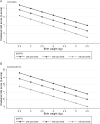Birth weight, cardiometabolic risk factors and effect modification of physical activity in children and adolescents: pooled data from 12 international studies
- PMID: 32494037
- PMCID: PMC7508671
- DOI: 10.1038/s41366-020-0612-9
Birth weight, cardiometabolic risk factors and effect modification of physical activity in children and adolescents: pooled data from 12 international studies
Abstract
Objectives: Low and high birth weight is associated with higher levels of cardiometabolic risk factors and adiposity in children and adolescents, and increases the risk of cardiovascular diseases, obesity, and early mortality later in life. Moderate-to-vigorous physical activity (MVPA) is associated with lower cardiometabolic risk factors and may mitigate the detrimental consequences of high or low birth weight. Thus, we examined whether MVPA modified the associations between birth weight and cardiometabolic risk factors in children and adolescents.
Methods: We used pooled individual data from 12 cohort- or cross-sectional studies including 9,100 children and adolescents. Birth weight was measured at birth or maternally reported retrospectively. Device-measured physical activity (PA) and cardiometabolic risk factors were measured in childhood or adolescence. We tested for associations between birth weight, MVPA, and cardiometabolic risk factors using multilevel linear regression, including study as a random factor. We tested for interaction between birth weight and MVPA by introducing the interaction term in the models (birth weight x MVPA).
Results: Most of the associations between birth weight (kg) and cardiometabolic risk factors were not modified by MVPA (min/day), except between birth weight and waist circumference (cm) in children (p = 0.005) and HDL-cholesterol (mmol/l) in adolescents (p = 0.040). Sensitivity analyses suggested that some of the associations were modified by VPA, i.e., the associations between birth weight and diastolic blood pressure (mmHg) in children (p = 0.009) and LDL- cholesterol (mmol/l) (p = 0.009) and triglycerides (mmol/l) in adolescents (p = 0.028).
Conclusion: MVPA appears not to consistently modify the associations between low birth weight and cardiometabolic risk. In contrast, MVPA may mitigate the association between higher birth weight and higher waist circumference in children. MVPA is consistently associated with a lower cardiometabolic risk across the birth weight spectrum. Optimal prenatal growth and subsequent PA are both important in relation to cardiometabolic health in children and adolescents.
Conflict of interest statement
The authors declare that they have no conflict of interest.
Figures



Similar articles
-
Moderate to vigorous physical activity and sedentary time and cardiometabolic risk factors in children and adolescents.JAMA. 2012 Feb 15;307(7):704-12. doi: 10.1001/jama.2012.156. JAMA. 2012. PMID: 22337681 Free PMC article.
-
Does body mass index modify the association between physical activity and screen time with cardiometabolic risk factors in adolescents? Findings from a country-wide survey.Int J Obes (Lond). 2017 Apr;41(4):551-559. doi: 10.1038/ijo.2016.210. Epub 2016 Nov 21. Int J Obes (Lond). 2017. PMID: 27867201
-
Total volume versus bouts: prospective relationship of physical activity and sedentary time with cardiometabolic risk in children.Int J Obes (Lond). 2018 Oct;42(10):1733-1742. doi: 10.1038/s41366-018-0063-8. Epub 2018 May 1. Int J Obes (Lond). 2018. PMID: 29717272
-
Health outcomes associated with reallocations of time between sleep, sedentary behaviour, and physical activity: a systematic scoping review of isotemporal substitution studies.Int J Behav Nutr Phys Act. 2018 Jul 13;15(1):69. doi: 10.1186/s12966-018-0691-3. Int J Behav Nutr Phys Act. 2018. PMID: 30001713 Free PMC article.
-
There Is a Clinical Need to Consider the Physical Activity: Sedentary Pattern in Children with Obesity - Position Paper of the European Childhood Obesity Group.Ann Nutr Metab. 2022;78(4):236-241. doi: 10.1159/000524570. Epub 2022 May 2. Ann Nutr Metab. 2022. PMID: 35500549 Review.
Cited by
-
Association between Objectively Determined Physical Activity Levels and Body Composition in 6-8-Year-Old Children from a Black South African Population: BC-IT Study.Int J Environ Res Public Health. 2021 Jun 15;18(12):6453. doi: 10.3390/ijerph18126453. Int J Environ Res Public Health. 2021. PMID: 34203654 Free PMC article.
-
The impact of macrosomia on cardiometabolic health in preteens: findings from the ROLO longitudinal birth cohort study.Nutr Metab (Lond). 2023 Sep 4;20(1):37. doi: 10.1186/s12986-023-00759-8. Nutr Metab (Lond). 2023. PMID: 37667333 Free PMC article.
-
A computational model to analyze the impact of birth weight-nutritional status pair on disease development and disease recovery.Health Inf Sci Syst. 2024 Feb 17;12(1):10. doi: 10.1007/s13755-024-00272-z. eCollection 2024 Dec. Health Inf Sci Syst. 2024. PMID: 38375133
-
Evening blue-light exposure, maternal glucose, and infant birthweight.Ann N Y Acad Sci. 2022 Sep;1515(1):276-284. doi: 10.1111/nyas.14852. Epub 2022 Jun 28. Ann N Y Acad Sci. 2022. PMID: 35764595 Free PMC article.
References
-
- Gluckman PD, Hanson MA. The developmental origins of health and disease: an overview. In: Gluckman P, Hanson M, editors. Developmental origins of health and disease. Cambridge: Cambridge University Press; 2006. p. 1-5.
-
- Risnes KR, Vatten LJ, Baker JL, Jameson K, Sovio U, Kajantie E, et al. Birthweight and mortality in adulthood: a systematic review and meta-analysis. Int J Epidemiol. 2011;40:647–61. - PubMed
-
- Yu ZB, Han SP, Zhu GZ, Zhu C, Wang XJ, Cao XG, et al. Birth weight and subsequent risk of obesity: a systematic review and meta-analysis. Obes Rev. 2011;12:525–42.. - PubMed
-
- Kohl HW, Craig CL, Lambert EV, Inoue S, Alkandari JR, Leetongin G, et al. The pandemic of physical inactivity: global action for public health. Lancet. 2012;380:294–305. - PubMed
Publication types
MeSH terms
Substances
Grants and funding
- MC_PC_19009/MRC_/Medical Research Council/United Kingdom
- R01 DK077659/DK/NIDDK NIH HHS/United States
- MC_UU_12015/3/MRC_/Medical Research Council/United Kingdom
- MC_UU_00006/4/MRC_/Medical Research Council/United Kingdom
- MC_UU_12015/7/MRC_/Medical Research Council/United Kingdom
- MC_PC_15018/MRC_/Medical Research Council/United Kingdom
- MC_UU_00006/5/MRC_/Medical Research Council/United Kingdom
- G0701877/MRC_/Medical Research Council/United Kingdom
- WT_/Wellcome Trust/United Kingdom
- R01 HL071248/HL/NHLBI NIH HHS/United States
- MR/K023187/1/MRC_/Medical Research Council/United Kingdom

